Science in Hollywood: I Origins (2014)
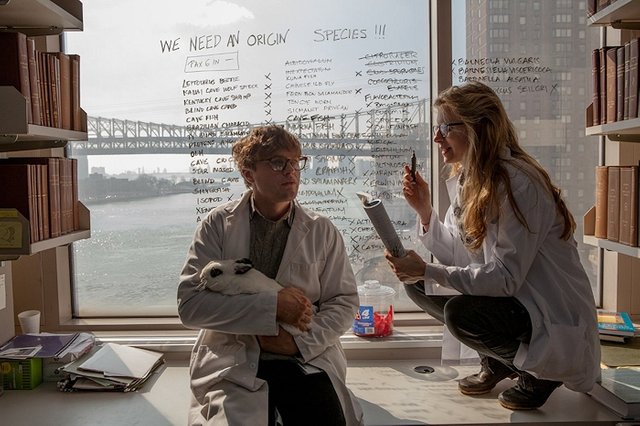
Science in Hollywood is a series of articles dedicated to talk about the science behind popular films.
DISCLAIMER: This post contains what I would call light spoilers, as in they reveal some aspects of the plot, but they are not crucial enough to give away the most exciting core of it. In other words, you can read this article and still enjoy the film without being spoiled about a key development of it. Enjoy!

Film: I Origins (2014)
Scientific topics: Evolution, molecular genetics.
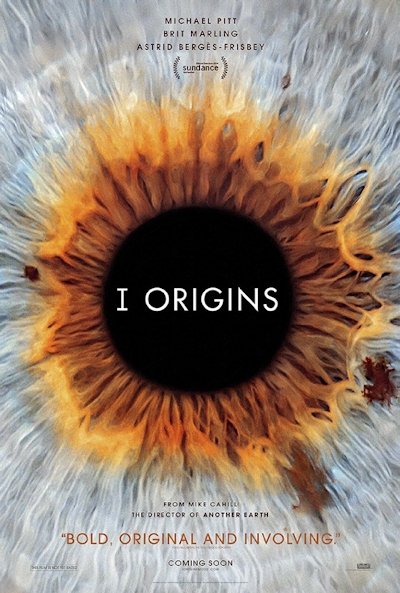
I Origins is about two biologists who make one of the greatest discoveries in the history of science, that has repercussions to every single person in this planet, challenging one of the most fundamental notions about their personal identity, and the physical and metaphysical meaning of life. (You can read a full review here)
I have to say that the lab work is pictured in a rather realistic way in this film.
Everything looks very close to the scientific reality: all the equipment, the way they use it and even the feel and look of the place (labs look the same everywhere in the world, trust me). They definitely must have had the advice of a good scientific consultant to polish and shape the science part of the film.
As a good example, take a look at this (spoiler free) clip of the film that includes a voice over of a TED talk about evolution:
In case you haven’t seen I Origins yet, I’ll quickly brief you about the scientific aspect explored in it:
Ian Grey, the main character of this film, is a scientist who has been fascinated by the human eye since he was a kid, and hence his doctoral work is focused on the topic of eye development.
His motivation is that he wants to dispel for good all the creationistic ideas about the origin of man and nature (“intelligent design”). Given that people who support creationism often use the eye as an example of an organ of irreducible complexity that could have not evolved gradually, that is the starting point he is taking, by proving how an eye as complex as the human one could have evolved step by step through evolution.
You can watch an explanation of his hypothesis in this clip (please overlook the fact that he is being a condescending jerk):
As part of his premise to show how something like the human eye could have gradually evolved out of more primitive bases, Ian proposes that the most convincing proof would be to manage to actually grow an eye in an organism that is normally “eyeless” –in order to demonstrate that the development of the eye is possible as a result of a few genes turned on at the right places instead of some magical fairy touch that creates fully formed eyes.
The Science behind it.
During the above quoted scene, they mention PAX6 as a key gene involved in the process of eye development.
This is certainly the case. PAX6 is a master regulator in the development of eyes and vision; it is a gene whose role is to turn on and off a particular set of genes that instruct the body to “make an eye”, thus orchestrating the transition from undifferentiated tissues in the embryo, to the complex, tridimensional structure that becomes the eye in a fully formed organism.
PAX6 was originally discovered by scientists performing experiments with fruit flies (Drosophila melanogaster), where they noted that some of them had severe ocular defects, a characteristic that they called eyeless; it was found that such eyeless flies had a mutant form of the gene PAX6, causing the abnormality.
PAX6 seems to have arisen pretty early in the evolutionary scale, since it is a gene that is highly conserved across vastly different species; what this means, is the sequence of the gene and the protein that PAX6 encodes is almost the same regardless of if it comes from a fruit fly, a mouse or a human.
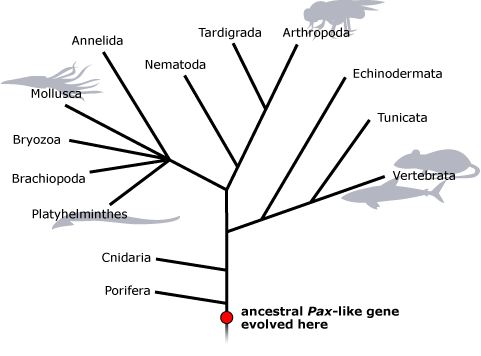
In fact, the power of the eye-making program encoded in PAX6 and directed by its product protein has been put to the test by some rather unorthodox scientists.
What they did, was expressing the PAX6 gene from a mouse into eyeless fruit flies; the fruit flies were then able to grow eyes even when the PAX6 gene expressed was not a “fly gene”. Furthermore, they decided to get even more creative –and perhaps slightly creepy– by proceeding to express the same PAX6 mouse gene in different parts of the fruit flies’ anatomy that normally don’t grow eyes (like the antennae, legs or wings), and… lo and behold! The mouse PAX6 gene was still effective to produce formation of eyes in this unusual locations when expressed in a targeted manner:
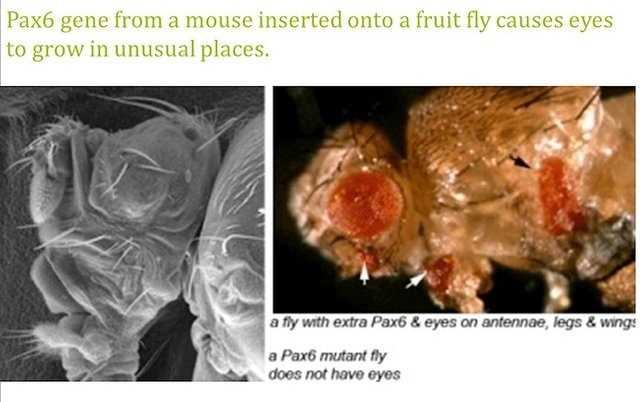
So, regardless where you put it, PAX6 expression has a clear message: Make an eye!
This further highlights how highly conserved and similar the gene is even between species that are evolutionarily very far apart, which opens the possibility to do research in convenient animal models that would directly give us a good insight or clues about what happens in humans.
A moment that I found funny about this film, was when Karen, the first year PhD student, just decides to start sequencing random eyeless organisms to find which one of them has the PAX6 gene, so they can go forth with their amazing experiment growing eyes in an eyeless creature by turning the right gene “on”.
She says that she has sequenced twelve so far… twelve! And she claims that she has about half a million of them left and she will keep moving down the list. Sequencing is expensive and time consuming, so good luck trying to sell that idea to your boss! I guess their lab most have been running on unlimited budget, or the director of the nearest sequencing unit had a life debt to repay to whomever was in charge of this scientific project…
Fun fact: The eyeless worm that they "discover" to have the PAX6 master switch (in the film), Eisenia fetida is actually a pretty common worm used for composting and as a fish bait.
However, it would seem that Ian and Karen, in typical grad student fashion, didn’t do a very thorough review of the literature available on the topic, since there is a species of worm that has been long identified as having no eyes while still having PAX6: our dear friend Caenorhabditis elegans, a nematode that is commonly used as a test subject in labs around the world –all the more reason to avoid all that unnecessary sequencing! I bet their boss’s pockets hurt now.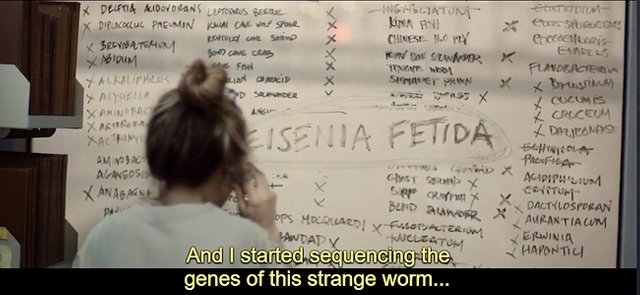
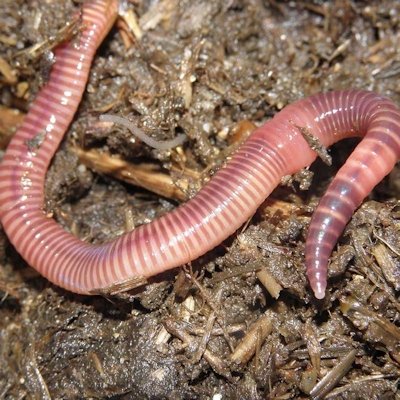
But we’ll give them a pass on that since that’s probably what they used for inspiration in the film –even though E. fetida are huge worms in comparison to C. elegans, which are about the size of a comma.
Is someone doing something like it?
There are numerous efforts being made by different research groups to reconstruct the step-by-step development of the architecture of the eye, using different animal models.
Different research groups have been studying how PAX6 operates at three levels of cellular differentiation: Cell fate specification and determination, morphogenesis (the signaling involved in cell cycle control and shaping of the organ) and terminal differentiation (crystallin gene expression).
Ironically, the focus on PAX6 research has also shown that there are many other genes involved in eye development, and in some rare organisms, the development and regeneration of eyes is independent of PAX6; that’s a lesson that science teaches us continuously: things are almost never as simple as they look in the beginning!
Therefore a goal like the one posed in this film could be achieved, but certainly not by just a couple of PhD students within the four or five years that a PhD usually encompasses. This would be more like a project with ten years running time, with several research groups working on it in a cooperative manner, using state-of-the-art methods – and probably an army of undergrad students doing slave labor for the most tedious and uninteresting parts of the job (as Ian dryly pointed it out himself in the film).

I hope you have enjoyed this first installment of the Science in Hollywood series, please feel free to leave any comments, suggestions, constructive criticism or opinions below!

Recommended reading: Why the Eye?
A 13 slide online presentation that very clearly and didactically explains the origin and evolution of eyes in nature. It has lots of very nice and illustrative pictures and diagrams, animations and short, concise explanations for every concept, making everything really easy to grasp while being very entertaining! Check it out, you might be pleasantly surprised.

References:
Induction of ectopic eyes by targeted expression of the eyeless gene in Drosophila.
https://www.ncbi.nlm.nih.gov/pubmed/7892602
Understanding Evolution – Homologous genes: Pax6
https://evolution.berkeley.edu/evolibrary/article/1_0_0/eyes_10
Eyeless worm senses light:
http://www.sciencemag.org/news/2008/07/eyeless-worm-senses-light
Patterning of the Caenorhabditis elegans head region by the Pax-6 family member vab-3:
https://www.nature.com/nature/journal/v377/n6544/full/377052a0.html
PAX6: 25th anniversary and more to learn
http://www.sciencedirect.com/science/article/pii/S0014483516300902
----------------------------------------------
The movie stills were taken from IMDB.
Another good post. I remember you recommending I Origins in your first Science in Hollywood article so I'm glad you wrote a bit more about it (and reminded me that I've got to give it a look). My favorite part was when you pointed out that C. elegans would be the obvious candidate species for this research. Its always fun to point out the nitpicks that are glaring to a scientists but common moviegoers wouldn't notice.
Thanks! Yes, and it also opens an opportunity to geek out and share some science with our audience here in Steemit. Yeah, having specialized knowledge in a field certainly creates lots of facepalm and WTF moments when watching a film, sometimes it adds to the fun, but in others, like in this case, there's quite a bit of real scientific material that gets presented to the public in an entertaining way.
I was just having a conversation yesterday about Conway's game of life and how it relates to simple rules giving rise to complex things (like the "creatures" you see when the game is set in motion). In a way, there is a design to it, but I think it does give credence to simple things giving rise to complex systems. For that reason, an "an eye is too complex to happen due to evolution" is not true.
Thanks for reminding me of it! Actually all those pioneering experiments in artificial life were the material that sparked my interest in evolution much further.
This is what the call "emergent processes" or qualities, those functions that would not be predictable just from looking at the individual parts and the general rules in which they interact. You are very right in your reasoning that this is most likely playing a big role on how systems as complex as the eye came to be.
This could be a topic for another post, I remember reading all these books on Autopoiesis (auto-organizing) and simulations of life, they had amazing concepts and quite awesome experiments carried out mostly in the 80's that now have been forgotten.
Thanks for this thoughtful comment, @theabsolute!
Very insightful post as always @irime !
I never fully understood the argument that is saying that evolutionary theory is flawed because no one can explain how the eye could have evolved into such a complex organ.
Yet, somehow it is established that the probably most complex animal organ - the human brain - evolved from a few cells specialized in stimulus recognition and propagation. The same goes for the eye: after some evolutionary grinding and mingling there was a dedicated cell type that could produce a protein that reacts to photons by changing the state of its structure or catalyzing a reaction.
Only because we do not understand how the eye exactly evolved step by step, yet, doesn't mean we won't so in the future.
Before Darwin, the idea that humans might have descended from some monkeys, was unheard of...
Also the concept of redundancy helps to understand how all these crazy functions have arisen. I used to think that there was like, one mutation that was conductive to conferring an organism with a new ability, however it has been shown that protein domains, for example, can have similar functions while being vastly different in their sequence.
BTW, is it just me or is Steemit now finally working properly?
Since the change of the interface it seems to be more stable.
I watched this movie finally the other weekend. It was... Okay. The ending was abrupt. The theme overly spiritual.
I really liked it, beyond the science in it being a lot more accurate than the average Hollywood film, it has a lot to offer from the artistic perspective.
However, I also felt like the more "spiritual" part suddenly took over halfway and then we were left wandering in this weird limbo that requires a big suspension of disbelief to ease the sense of implausibility. Still, I think it was an original effort to merge both science and metaphysical themes.
just dropping by to say I love your posts :)
@trumpman, Thanks for stopping by! And for letting me know ;-) Cheers!
At some point genetics enters the spiritual plane. The religious beliefs that have accompanied us for millennia have imprinted on our subconscious that life comes from a higher being, a god.
Do you mean something like Carl Jung's idea of the archetypes?
It was actually a reflection based on Jung's theories. Yes.
Based on the conversations I had with an old friend biologist who worked in the field of genetics years ago. In these conversations I could see how the passion for scientific advances clashed with those ancestral archetypes described by Jung.
@irime, I have read some of your posts, very impressive.
but this post I will save and read later
thanks for share it :)
@kharrazi, no problem, thank you for the nice feedback :-)
my dear friend @irime, I am confused which one to answer because you have answered twice with the same writing :P
It is because Steemit is glitching again and giving me a hard time posting comments. But you seem to have found the right one ;-)
great post.i like your post and following.
Thank you!
I find it super interesting all the information, but what I called my attention was the crystalline gene expression Cool!
Your post is very good and I can make as a motivation in expanding my knowledge in deepening my knowledge distemem